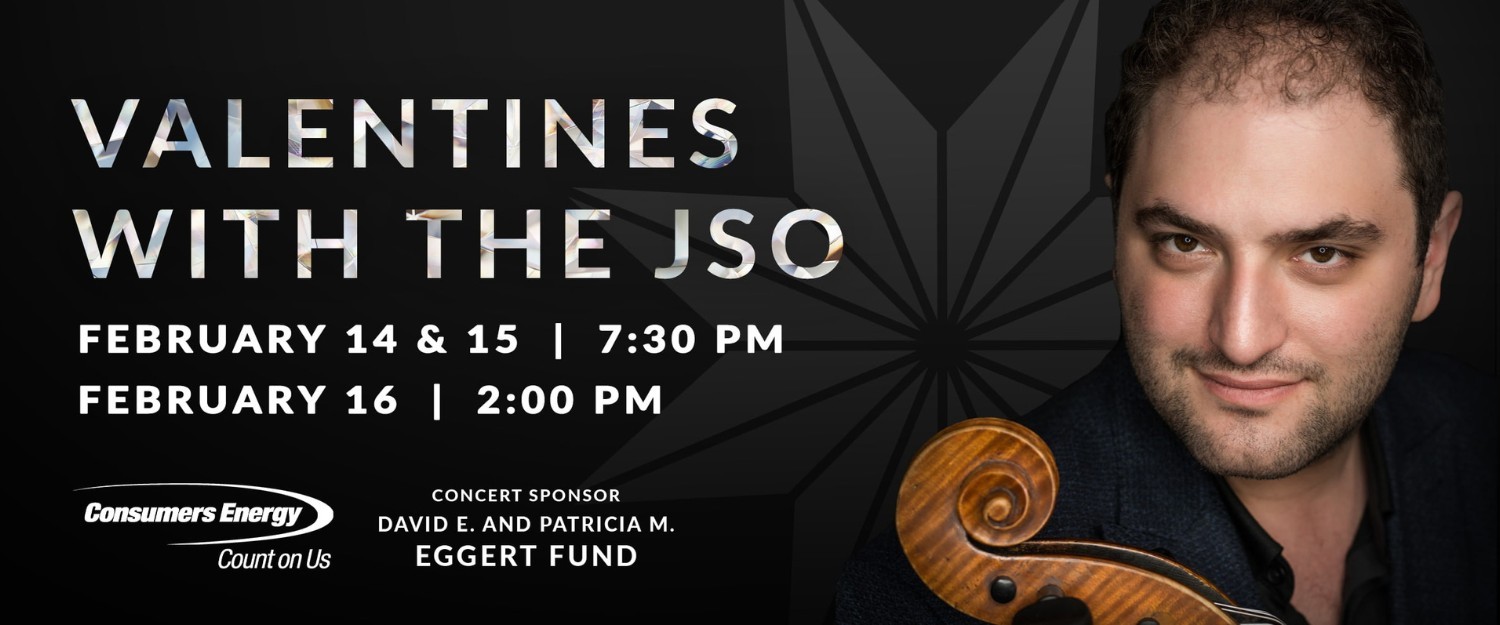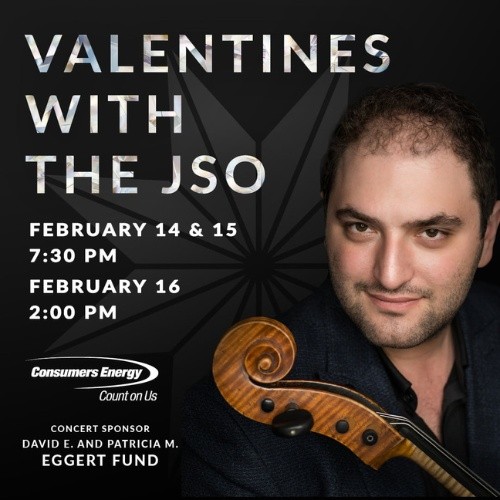

PROGRAM NOTES
VALENTINES WITH THE JSO
FEBRUARY 14-16, 2025
Variations on a Theme of Joseph Haydn, op. 56a | Johannes Brahms (1873)
Good things often come in modest packages, and this work is unquestionably one of those. Many have observed that Johannes Brahms was the major successor to the legacy of Beethoven in a century filled with musical progressives who moved in other directions. The darlings of that time—and in many regards, of today, as well—were those, like Wagner and Liszt, who opted for hyper expressive means that explored new forms and which relaxed the conventions of the classic style. Brahms was the champion of those who eschewed extra-musical associations (stories and ideas, if you will), and persisted in composing music that referred to nothing but itself. He resisted more than anyone the blandishments of Wagner and company.
This set of variations for orchestra was written in 1873, and is eloquent testimony to the composer’s growing mastery of the technique of variation. The variations are based upon a simple little theme that at the time of Brahms’ composition was thought to be by Joseph Haydn—we now know that the attribution is incorrect. But, the name lives on, in any case. Brahms’ variations are not the common kind that takes a memorable melody and simply embellishes it with growing animation and figuration as one follows along with the skeleton of the melody. Rather, those of Brahms’ “Haydn” variations are what are known as “character” variations. They abstract some small aspect—often without a clear connection in the listener’s mind—and create a series of meditations and rhapsodic developments in which the melody is not often palpable.
The theme itself, however simple, is interesting in that it is comprised of two five-measure phrases—more commonly one will find four-measure phrases. The “extra” bar can easily be heard as the third measure in each of the two main phrases (count it for yourself). Following the statement of the theme are eight “character” variations and an extended finale. Hearing a connection between a character variation and the original theme can be difficult, but a close listen to the second variation will reveal how Brahms has constructed an entire section out of just the first three notes of the theme. Listen for it for a lesson in imagination! Other variations ensue accordingly. Particularly ingratiating is the seventh variation, wherein one hears, perhaps, most clearly, a connection with the style of Brahms’ wonderful short works for piano, especially the ballades and intermezzos. Brahms often composed works first for two pianos before orchestrating them, and if you listen to that version of this work, the putative connection is easy to hear.
The finale is a tour de force of Brahms’ mastery of the higher techniques of traditional composition. J. S. Bach, himself, would have been proud of Brahms’ infusion into this section of all manner of contrapuntal devices. It’s a veritable textbook of counterpoint: canons, double counterpoint, and more. But the important point is that they don’t have to be understood, or even heard clearly, to sense the profound, but universal appeal of one of Brahms’ greatest achievements. And it all takes place without the slightest need for a “story.” This is music spun from music, alone.
Written by William E. Runyan.
Variations on a Rococo Theme, op. 33, TH 57 | Piotr Ilyich Tchaikovsky (1876)
Piotr Ilyich Tchaikovsky (1840–1893) composed Variations on a Rococo Theme, op. 33, in 1876, as an homage to the elegance and balance of 18th-century classical music. The theme, though an original creation, reflects the charm and grace of the Rococo style. Tchaikovsky was deeply inspired by Wolfgang Amadeus Mozart, whom he considered his “musical god,” and this piece captures the clarity of classical traditions while infusing them with Tchaikovsky’s Romantic voice.
The Variations on a Rococo Theme begins with an orchestral introduction, followed by a graceful theme presented by the solo cello. This theme serves as the foundation for eight variations, though in some interpretations, the theme itself is counted as the first section, resulting in a total of nine labeled parts. The version most frequently performed today includes only seven variations, as Wilhelm Fitzenhagen—the cellist who premiered the work—omitted the eighth variation and rearranged the order of the others. Tchaikovsky expressed frustration with these edits, but Fitzenhagen’s version became the standard.
The variations explore a wide range of styles and moods, from virtuosic passages that showcase the soloist’s technical brilliance to tender, lyrical moments that highlight the cello’s expressive qualities. A notable section is the sixth variation (Moderato con moto), which contrasts lyrical introspection with lively accompaniment. The piece concludes with a triumphant finale, filled with dazzling technical displays and infectious energy.
Variations on a Rococo Theme premiered in Moscow in 1877, with Fitzenhagen as the soloist. Despite the controversy surrounding the edited version, the work remains a cornerstone of the cello repertoire, beloved for its blend of classical poise and Romantic expressiveness. It offers a fascinating journey through Tchaikovsky’s interpretation of Rococo elegance, brought vividly to life through the cello’s voice.
“Andante Cantabile” from String Quartet, op. 11 | Piotr Ilyich Tchaikovsky (1888)
Piotr Ilyich Tchaikovsky (1840–1893) composed Andante cantabile in its original form as the second movement of his String Quartet No. 1 in D major, op. 11, in 1871. By 1888, the piece had gained immense popularity, prompting Tchaikovsky to arrange it for cello and string orchestra, giving it a new life in concert halls. The work remains one of his most enduring and beloved melodies, renowned for its poignant simplicity and emotional depth.
The theme of Andante cantabile is believed to have been inspired by a Russian folk song, “Vanya Sat on the Couch,” which Tchaikovsky reportedly heard sung by a house painter while visiting his sister’s estate in Kamenka. This influence gives the piece its nostalgic and heartfelt quality, reflecting Tchaikovsky’s admiration for the simplicity and soulfulness of Russian folk music.
The arrangement for cello and string orchestra allows the cello to sing the main melody with rich expressiveness, supported by delicate, flowing lines in the strings. The piece unfolds with a quiet, introspective mood, moving seamlessly between moments of deep longing and tender beauty. Its title, Andante cantabile—“slowly, in a singing style”—perfectly captures the essence of the work.
One of the most striking elements of Andante cantabile is its emotional directness. Tchaikovsky’s gift for crafting melodies that resonate universally is evident here, and the work has been admired by audiences and musicians alike. Leo Tolstoy, the great Russian writer, is said to have been moved to tears upon hearing the piece, praising its emotional power and simplicity.
Andante cantabile has become a staple in the cello repertoire, cherished for its lyricism and emotional depth. For audiences, it offers a profound and intimate experience, showcasing Tchaikovsky’s ability to distill profound emotion into the simplest and most beautiful musical forms.
Symphony No.5, D.485, B-flat Major | Franz Schubert (1816)
The epitaph on Schubert’s tombstone reads: “The art of music has entombed here a rich treasure but even fairer hopes.” We all lament the “loss” of treasure that we never possessed, none perhaps more than great art that we presume may have come to pass but not for lives cut short in youth. But not all composers can live long productive lives like those enjoyed by Verdi and Strauss, for example. Often those who die young are nevertheless privileged to accomplish much, and Schubert, like Mozart, is exemplary. He left behind him a legacy of over six hundred art songs; no other composer’s contribution to the genre is as significant in scope and number. And, of course, while he did compose marvelous chamber works, symphonies, and music for piano, it is his inimitable gift for melody – the essence of his Lieder – that equally informs and carries his instrumental works.
His short life was generally uneventful, and his personality still is somewhat lacking in vivid details for us today, but we do know that he lived and worked within a small circle of artists in various fields in Vienna. His was contemporaneous with Beethoven, but that master’s music exerted little influence upon Schubert; Haydn and Mozart were his models. His teenage years yielded much more profound results than did those of Beethoven, Schubert having composed over one hundred and fifty songs in his eighteenth year (almost one every three days)! The next year (1816) was almost as productive, with over one hundred songs and two symphonies—including the Symphony in B flat Major.
Schubert’s fifth symphony is almost as well known as the two late, mature ones, so popular with today’s audiences, the so-called “Unfinished” and the “Great” C Major. But this early work is a different take on the genre. It certainly calls to mind the early symphonies of Mozart—and even alludes to portions of that composer’s early G minor symphony. It is modest in length, light in orchestration (no clarinets, trumpets, or drums), and terse in development. What is noteworthy are its melodious themes and interesting harmonies—all lifelong characteristics of Schubert’s works. The first movement gets right to the point with two attractive melodies heard almost immediately, but what is of equal interest are the arresting and unusual key areas heard later: D-flat major and E-flat minor. While the typical concertgoer may not recognize these keys by name, he will sense the richness of harmony, just as almost anyone can hear the same in a Gershwin song. So listen for it! The slow, second movement exhibits the same melodic inventiveness and harmonic adventures—even modulating to the rare key of C-flat major. The third movement really does sound like a rough, vigorous minuet by Haydn (rather old fashioned by then), but Schubert’s elegant melodic gift surfaces in the contrasting middle section. The last movement is a cheerful romp that sounds like it could have been composed some forty years earlier. So, we have a youthful work here, one that takes Haydn and Mozart as points of departure, and blends in delightful touches of Romantic melody and harmony, all so different from that of Schubert’s stormy contemporary, Beethoven.
Written by William E. Runyan.
PROGRAM SCHEDULE
Johannes Brahms
Variations on a Theme of Joseph Haydn, op. 56a <1873>
Piotr Ilyich Tchaikovsky
Variations on a Rococo Theme, op. 33, TH 57 <1876>
Piotr Ilyich Tchaikovsky
Andante cantabile <1888>
Franz Schubert
Symphony No.5, D.485, B-flat Major <1816>
| RUNTIME: 1H 45M |
